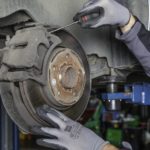Quick Navigation
- Symptoms Of A Secondary Collision Brake System Malfunction
- Causes Of A Secondary Collision Brake System Malfunction
- How Can You Troubleshoot Secondary Collision Brake System?
- Solutions To Secondary Brake Collision System Malfunction
- How Can You Tell If Your Secondary Collision Brake System Is Malfunctioning?
- Fixing A Secondary Collision Brake System Malfunctioning Car
- Is It Safe To Drive With A Failed Secondary Collision Brake System?
- How Can You Prevent Your Secondary Collision Brake System From Malfunctioning?
- What Should You Do If Your Secondary Collision Brake System Malfunctions While Driving?
- How Often Should You Check Your Secondary Collision Brake System?
- Conclusion
A secondary collision brake system malfunction can be caused by various factors, such as a defective sensor or a clogged hose.
If your car’s secondary collision brake system does not work correctly, it can increase the risk of an accident.
It’s also crucial to properly fix a secondary collision brake system malfunction to keep you and your passengers safe.

This article will discuss the causes of a secondary collision brake system malfunction and some solutions to fix the problem.
Symptoms Of A Secondary Collision Brake System Malfunction
If your secondary collision brake system is not functioning correctly, you may experience one or more of the following symptoms:
- The vehicle does not stop after a collision
- The brakes are applied unexpectedly
- The brakes are applied too forcefully
- The vehicle pulls to one side when the brakes are applied
Causes Of A Secondary Collision Brake System Malfunction
There are several potential causes of a secondary collision brake system malfunction, including:
- Incorrect installation or maintenance
- Worn or defective components
- Damaged or blocked hydraulic lines or valves
- Electrical faults in the control uni
How Can You Troubleshoot Secondary Collision Brake System?
If you experience problems with your secondary collision brake system, there are several steps you can take to troubleshoot and solve the issue:
- Check the hydraulic fluid level and condition
- Inspect all brake components for damage or wear
- Check the electrical wiring for signs of damage or corrosion
- Test the system’s operation using a diagnostic scanner
If you cannot troubleshoot and solve the problem, have a qualified technician inspect the system.
Solutions To Secondary Brake Collision System Malfunction
To fix a secondary brake collision system malfunction, follow the procedures below.
Cleaning The Vehicle
Dust collects in various areas of the vehicle, causing it to lose its functionality.
When particular regions of the car become clogged with dirt, the DTCs in the car warn you that the sensors’ mechanism is being hampered.
You can avoid the secondary brake collision system malfunction by thoroughly washing your car or focusing solely on these openings.
To avoid such situations, you should thoroughly clean your car regularly.
The cruise control system may also cause problems with the braking system. It may be tough to activate the brakes if it thinks the current speed is the best.
The system may fail to recognize a steady and rapid increase in speed as a collision signal. It keeps the car accelerating at a consistent rate.
As a result, you’ll need to re-calibrate the system in such circumstances.
Turning off the cruise control and then on again in the back may help you fix the secondary brake collision system problem.
However, it may harm the battery, resulting in more faults and problems. As a result, you must use caution when carrying out this procedure.
How Can You Tell If Your Secondary Collision Brake System Is Malfunctioning?
A few symptoms can indicate that your secondary collision brake system is not functioning correctly.
For instance, it could be a problem if the brakes do not engage or if the vehicle does not stop as quickly after a collision.
Additionally, if you notice any damage to the brake components or electrical wiring, this could also indicate a malfunction.
If you think that your secondary collision brake system is not working correctly, it is essential to have it checked by a qualified technician as soon as possible.
This way, they can diagnose the problem and determine the best course of action.

Fixing A Secondary Collision Brake System Malfunctioning Car
If a secondary collision brake system is not functioning correctly, there are a few possible solutions. One option is to check the hydraulic fluid level and condition.
Additionally, all brake components should be inspected for damage or wear.
You should also check the electrical wiring for signs of damage or corrosion. Another potential solution is to test the system’s operation using a diagnostic scanner.
If the problem cannot be fixed by troubleshooting, it is essential to have a qualified technician inspect the system.
Secondary collision brake systems are an essential safety feature in vehicles. It is crucial to make sure that they are functioning correctly.
By being aware of the common causes of problems and knowing how to troubleshoot them, you can keep your car safe on the road.
Is It Safe To Drive With A Failed Secondary Collision Brake System?
No, it is not safe to drive with a secondary collision brake system that is not functioning correctly.
It is because the system is responsible for stopping the car in the event of a collision.
If it is not working correctly, there is a greater risk of being involved in another crash.
It is essential to have the system checked by a qualified technician as soon as possible if you think there may be a problem.
Driving with a secondary collision brake system that is not functioning can put you and others at risk.
How Can You Prevent Your Secondary Collision Brake System From Malfunctioning?
One way to prevent your secondary collision brake system from malfunctioning is to have it regularly serviced by a qualified mechanic.
Additionally, inspect your vehicle’s brakes regularly and replace any worn-out or damaged parts as soon as possible.
Finally, always drive within the posted speed limit and never tailgate other vehicles.
By following these simple steps, you can help ensure that your secondary collision brake system will function properly in the event of an accident.
What Should You Do If Your Secondary Collision Brake System Malfunctions While Driving?
If your secondary collision brake system malfunctions while driving, the best thing to do is pull over and stop as soon as possible.
Once you are safely off the road, call a tow truck or qualified mechanic to come and inspect your vehicle.
Do not attempt to drive your vehicle until the problem has been fixed, as this could potentially lead to another accident.
If you are involved in an accident and your secondary collision brake system does not function properly, remain calm and not panic.
Remember that it is still possible to slow down or stop your vehicle using the primary brake system, so do your best to control the car’s speed and direction.
If possible, move out of the way of oncoming traffic and wait for help to arrive.
By following these tips, you can minimize the risk of further injury or damage in the event of a collision.
How Often Should You Check Your Secondary Collision Brake System?
It is essential to regularly check your secondary collision brake system to ensure it is in good working condition.
Additionally, it is good to have the system inspected by a qualified technician at least once a year.
This way, they can catch any problems and prevent them from worsening.
Regularly checking your secondary collision brake system and having it inspected by a qualified technician can help keep you safe on the road.
By being proactive, you can prevent problems and keep your car in good condition.
Conclusion
Regularly checking your secondary collision brake system and having it inspected by a qualified technician can help keep you safe on the road.
By being proactive, you can prevent problems and keep your car in good condition.
So, I hope this article helped teach you the importance of secondary collision brake systems and how to maintain them.

Patrick started his love affair with cars in his childhood. Over the years, he claims a sturdy hold on his driving skills, along with a thorough understanding of cars. We can expect some interesting, holistic, and pleasurable blogs with his flair for writing and his love for cars.
Being a car enthusiast, Patrick has experience comprising of two decades in which he has ridden some of the meanest and strongest machines in the automotive industry. His previous avatars include an automotive professional, photographer, and journalist, and you will certainly experience the roundness of experience in his piece on this site.
In his second decade of reviewing cars and analyzing tools, Patrick is all set to give you convincing, reliable, and the latest information regarding what’s happening in the automotive industry. Currently, he owns a BMW Z3 but cannot get his eyes off Aston Martin DB5. He is a car enthusiast; he loves cooking and listening to music, especially jazz. Here are some of the pieces written by our ace author.






